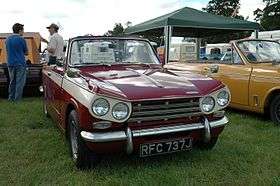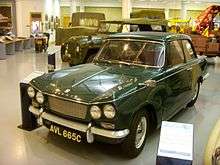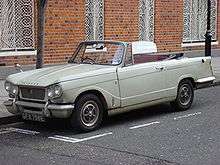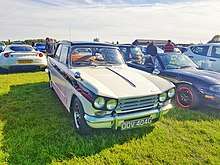Triumph Vitesse
The Triumph Vitesse is a compact six-cylinder car built by Standard-Triumph from May 1962 to July 1971. The car was styled by Giovanni Michelotti, and was available in saloon and convertible variants.
| Triumph Vitesse | |
|---|---|
 | |
| Overview | |
| Manufacturer | Standard-Triumph |
| Production | 1962–1971 51,212 built |
| Designer | Giovanni Michelotti |
| Body and chassis | |
| Body style | Two-door saloon Two-door convertible Three-door estate (by special order) |
| Related | Triumph Herald, Triumph GT6 |
| Powertrain | |
| Engine | 1596 cc or 1998 cc Triumph I6 |
| Transmission | Four-speed manual, RWD Optional overdrive |
| Dimensions | |
| Wheelbase | 91.5 in (2,324 mm)[1] |
| Length | 153 in (3,886 mm) |
| Width | 60 in (1,524 mm) |
| Height | 52.5 in (1,334 mm) |
| Curb weight | 2,072 lb (940 kg) |
| Chronology | |
| Successor | Triumph Dolomite |
The Vitesse name was first used by Austin on their 1914–16 Austin 20 (hp) and 30 (hp) Vitesse models, this was followed in 1922 by G. N.(Godfrey & Nash) on their GN Vitesse Cyclecar, and then by Triumph on a car made between 1935 and 1938.
After the last Triumph Vitesse was made in July 1971, the name remained unused until October 1982, when Rover used it on their SD1 until 1986, and one final time on their Rover 800, 820 and 827 models from October 1988 to 1991, at which time that car was rebodied as the R17 version, which was produced until 1998 as the Rover Vitesse Sport.
Vitesse 6

The Triumph Vitesse was introduced on 25 May 1962, reusing a name previously used by the pre-Second World War Triumph Motor Company from 1936–38, and was an in-line 6-cylinder performance version of the Triumph Herald small saloon. The Herald had been introduced on 22 April 1959 and was an attractive 2-door car styled by the Italian designer Giovanni Michelotti. Within 2 years, Triumph began to give thought to a sports saloon based on the Herald and using their 6-cylinder engine. Michelotti was again approached for styling, and he came up with a car that used almost all body panels from the Herald, combined with a new front end with a slanted 4-headlamp design.
Standard-Triumph fitted a 1596 cc version of their traditional straight-6 derived from the engine used in the Standard Vanguard Six, but with a smaller bore diameter of 66.75 mm (2.628 in), compared with the 74.7 mm (2.94 in) bore on the Vanguard, equipped with twin Solex B32PIH semi-downdraught carburettors These were soon replaced by B321H carburettors, as the accelerator pumps proved a problem. The curious observer will notice a "seam" on the cylinder block between the third & fourth cylinders revealing the humble design beginnings from the 803 cc Standard SC engine block first used in the Standard Eight of 1953. The gearbox was strengthened and upgraded to much closer (more sporting) gear ratios, and also offered with optional Laycock De Normanville 'D-type' overdrive that offered a top gear with a 20% higher ratio (the equivalent change from 3rd to 4th in a standard box), giving more relaxed and economical cruising at the expense of slight oil drag from the pump in the overdrive unit. Models fitted with overdrive had a chrome badge with "Overdrive" in italic text on the Left side of the boot opposite the Vitesse 6 chrome script badge on the right. Synchromesh was present on 2nd, 3rd and 4th. The rear axle was changed to a slightly uprated differential, but retaining the same 4.11:1 ratio and flange sizes as the Herald. Front disc brakes were standard as were larger rear brake drums, and the Herald fuel tank was enlarged, retaining the handy reserve feature (essentially a curved pickup pipe that could be rotated to dip into the last few centimetres of fuel) of the smaller Herald tank. The front suspension featured uprated springs to cope with the extra weight of the new engine, but the rear suspension was basically standard Herald—a swing-axle transverse-leaf system which quickly proved inadequate for the relatively powerful Vitesse. The chassis looked similar to the early Heralds but in fact was substantially re-designed and strengthened, especially around the differential mountings (and these improvements were immediately passed through to Herald production). The dash and instrument panel of the earliest Vitesse was the same as the herald, with a single speedo dial featuring fuel and temperature gauge insets. The Vitesse was available in convertible and saloon forms; a coupé never got beyond the prototype stage. The separate chassis construction of the car meant that no additional strengthening to chassis or body was considered necessary for the convertible model, the only concession being additional door catches to prevent the doors opening during hard cornering. The gearboxes of all the Vitesse and GT6 models were a weak point being derived from the earlier Heralds. The increased power caused accelerated wear on the bearing and forward end of the main shaft which would eventually wear through the hardened surface, leading to large amounts of play between the input and main shafts. This was characterised by growling gear noise on acceleration and deceleration in 1st, 2nd and 3rd getting high in each gear as the torque transmission from the lay shaft moved further from the rear of the box where the bearing support was intact. Repair involved either a new mainshaft or metal spraying/stellite repair. Some engineers suggested repairs were more long lived than a new shaft as the technology 10-20 and more years after manufacture meant that the repaired mainshaft had better specifications that new old stock. The remote lever construction suffered from the same regular bushing wear as the herald spitfire etc where sloppy gearchange and rattling can be cured (easy diy job) with a kit of new parts. A handful of Vitesse estates also were assembled to special order at Standard-Triumph's Service Depot at Park Royal in West London.
The interior was much improved over the Herald; wooden door cappings were added to match the wooden dashboard and the car featured slightly better seats and door trims. Optional extras included a vinyl/fabric, (Britax Weathershield), sunroof on saloon models. Exterior trim was also improved with an elongated stainless steel trim piece which extended further down the body than the Herald, including a Vitesse specific piece of trim rearward of the petrol filler cap and satin-silver anodised alloy bumper cappings replacing the white rubber Herald items. In September 1963 the Vitesse received its first facelift, when the dashboard was revised with a full range of Smith instruments instead of the large single dial from the Herald (large speedometer and cable driven tachometer flanked by smaller 2 inch fuel and temperature gauges). From September 1965, at commission number HB27986, the twin Solex carburettors were replaced by twin Stromberg CD 150 carburettors. Power output increased from the original 70 bhp (52 kW) at 5,000 rpm and torque of 92.5 lb⋅ft (125 N⋅m), enough to provide a useful performance boost and making the car a more flexible performer. There was a claimed, although somewhat optimistic increase of 13–14 bhp, and the motoring magazine tested top speed rose to 91 mph (146 km/h), with the 0–80 mph (0–129 km/h) time decreasing from 46.6 seconds to just 33.6 seconds.
The Vitesse 6 sold extremely well for Triumph, and was by some way the most popular Vitesse sold during the model's lifetime. The car was well liked for its performance and reasonable fuel economy, and the well-appointed interior. The exceptionally small turning circle was also liked by users. With its ability to perform as well as many sports cars, but with room for a family, the Vitesse had few rivals for the price. The convertible in particular was virtually unique in the marketplace; another genuine four-seater sporting convertible would not reappear from a British manufacturer until the Triumph Stag several years later.
Sports 6
The Vitesse 6 convertible was exported to the US as the left-hand drive Triumph Sports 6, from 1962 until 1964. It was marketed as a "limited edition car", but because of its retail price only 679 were sold before it was withdrawn.
The Sports 6 was perhaps better suited to American highways than was the Herald, but it faced stiff price competition from cars such as Ford's new Mustang. The Vitesse Saloon was not officially imported to the US, although a few do come up as P.E.D. (Personal Export Delivery), cars usually imported by American service personnel. Original US price (POE East Coast) was $2,499 for the Sports 6 Convertible, which was usually delivered in White, Signal Red or Black.
Vitesse 2-Litre

In September 1966 Triumph upgraded the engine to 1998 cc, in line with the new Triumph GT6 coupé, and relaunched the car as the Vitesse 2-Litre. Power was increased to 95 bhp (71 kW), endowing the new car with a claimed 0–60 mph time of just under 12 seconds, and lifting top speed to 104 mph (167 km/h). (The 2-Litre was advertised by Triumph as "The Two Seater Beater"). The performance increase was welcome, but it highlighted the deficiencies of the rear suspension. Other detail modifications for the 2-litre, included a stronger clutch, all synchromesh gearbox, larger front brakes (still without a servo), and a stronger differential with a slightly higher 3.89:1 ratio. Wider & stronger 4.5-inch wheel rims were fitted, but radial-ply tyres were still optional, at extra cost. There was a satin silver anodised aluminium-alloy cowling above the new reversing light, and badges on the side of the bonnet and in the centre of the grille read 2 litre. The Vitesse boot badge was retained as italic script but lost the 6 of the earlier model - replacing that with the rectangular 2 litre badge and with a chrome strip underlining the Vitesse badge. Cars with overdrive had a separate badge on the cowling above the number plate/reversing light. Inside the car, the seats were greatly improved, with softer (more plush) covering and a better back-rest shape which slightly improved rear-seat knee-room. A new leather-covered three-spoke steering wheel was also added.
Vitesse Mk II
The Vitesse Mark 2 was launched in October 1968 as the final update to the Vitesse range. Essentially intended to be Triumph's answer to growing criticism of the rear suspension, the Mark 2 was fitted with a redesigned layout using new lower wishbones and Rotoflex half-shaft couplings. This system, also shared with the new GT6 MKII (GT6+ in the US market), and the first GT6 MkIIIs, tamed the wayward handling and endowed the Vitesse with more firm, progressive roadholding. The solid swing axles of the Herald and earlier Vitesses had camber changes of some 15 degrees from the limits of travel. By adding the lower wishbone and the divided drive shaft whilst retaining the transverse leaf spring as the top link, this camber change was reduced to about 5 degrees. While this was a considerable improvement, it was still a system that struggled to keep up with a really good link-located live axle (such as Triumph would introduce on the Toledo, 1500TC and later Dolomite saloons).
There were other improvements: the engine was tweaked once more to provide 104 bhp (78 kW), cutting the 0–60 mph time to just over 11 seconds and providing a top speed of over 100 mph (160 km/h). The main changes were to the valve timing, to give earlier opening and later closing of the inlet valves compared with the earlier 2-litre engine. (38/78 btdc/atdc for the Mk2 vs 30/60 for the 2 litre). Design changes to the cylinder head allowed for increased inlet valve diameters and better porting. Another major difference in the cylinder head removed the "step" in earlier 1600 and 2 litre incarnations. This meant that in the earlier cars the head studs on the right (manifold) side were short and ended under the manifolds, necessitating unbolting the (hot) manifolds and dropping them back to retorque the studs after a head gasket replacement. The MKII head was full width so all the studs were accessible. The inlet manifolds of the mkII were shorter than the 2 litre to keep inlet tract length the same. The Stromberg carburetors were also changed from 150 CD to 150 CDS, the S referring to the use of a spring between the dashpot cover and piston. The exterior featured a new grille with 3 sets of horizontal elements that were also used (in longer form) in the herald 13/60, Rostyle wheeltrims and silver painted steel rear panel, (described by Triumph as "ceramic"), and the interior was upgraded once more in order to share parts with the new Herald 13/60, although there were significant differences between the two models; the inclusion of a tachometer being an obvious one, the provision of a larger ash tray in the Vitesse not quite so obvious. A new colour range was offered for the Mark 2 models. The aluminium cowling above the reversing light gained an oblong chromed VITESSE badge, and the separate chromed mezak TRIUMPH letters on the bonnet and the boot lid were also deleted. The badges on the bonnet sides were changed to read Mk2 instead of 2 litre. Cars with overdrive had a small badge that fitted below the new rectangular Vitesse boot badge.
This was the ultimate Vitesse, a saloon or convertible with performance superior to the MGB and the Sunbeam Alpine sports car[2] (in both acceleration and top speed) but with four seats and a large boot. Contemporary testing in the UK press listed the Vitesse's 0-70 mph time as 15.0 seconds against 17.9 for both the MGBGT and the Sunbeam Alpine Series IV, and standing-quarter-mile times were 18.1, 19.5, and 19.0 respectively [3].
The Vitesse sold well until its withdrawal in July 1971, seven months before the new Triumph Dolomite saloon entered the performance luxury sector for Triumph. Although the Vitesse was an older model, it proved to be more reliable than its replacement, due to its simpler and more proven engine design [4].
Production figures
- Vitesse 6 (1600): May 1962 – September 1966; 31,261
- saloon: 22,814
- convertible: 8,447, includes 679 Sports 6 (USA)
- Vitesse 2-Litre: September 1966 – September 1968; 10,830
- saloon: 7,328
- convertible: 3,502
- Vitesse Mk II: July 1968 – July 1971; 9,121
- saloon: 5,649
- convertible: 3,472
Racing
The Vitesse competed in the Monte Carlo Rally in the early 1960s and the Trans-Am in 1971.
A number of performance upgrades were available for Vitesses, during and after production. Many were provided by SAH Accessories, later owned by Dunham and Haines in Dunstable, north of London. The "Tite-a-turn" modification was an attempt to tame the early swing axle suspension by increasing the resistance to suspension extension on the inside rear wheel (and the transition into positive camber) while allowing normal compression into negative camber on the outer wheel. Engine modifications went from simple cosmetics like an alloy rocker cover to more serious changes. Alloy manifolds for triple twin-choke Weber or Dellorto carburetors were available and gave considerable improvements in acceleration and top speed especially if coupled with SAH's tubular exhaust manifolds (2x3 into 1, then 2 into 1), straight through rear box/twin boxes and camshaft changes. The exhaust manifolds of the factory Vitesse were crude cheap 6-1 castings and considerable improvements in performance (and sound) could be realised by fitting the SAH steel tubular manifolds 2x(3-1) the 2-1 or 2-2 separate pipes to rear silencer boxes.
Some owners realised that the long stroke 2.5-litre engine fitted to the TR5/6 and 2.5PI had the same dimensions as the 2-litre engine, and could be fitted to the Vitesse simply by swapping the rear engine plate, input shaft bush, and clutch, then bolting on Vitesse engine mounts. In fact it was practical (and virtually undetectable!) to strip the Vitesse Mk2 engine and rebuild with 2.5 crankshaft, pistons, and cylinder head to achieve this capacity increase. Some repowered 2.5-litre cars were fitted with the original Stromberg CD150s, some with Webers or Dellortos, and some even kept the problematic but effective mechanical Lucas petrol injection system. Unfortunately the Vitesse gearbox and differential were not really up to a 150 hp 2.5-litre engine's output. Fitting the gearbox from the 2.5 was not as simple as the engine so this remained a problem for most with the 2.5.
The weight distribution of the Vitesse was also a problem as the large engine balanced over the front axle meant rear weight was not optimal. Some owners moved/removed the heater and modified the bulkhead to allow the Vitesse engine to sit further back giving greatly increased balance/lower polar moment and a bit of reduced rear ride height.
Today
Today, the Triumph Vitesse is much sought-after car by enthusiasts; parts supply is excellent, and the cars have a reputation for near "bullet-proof" mechanics. This is not completely warranted. The gearbox of the 2 litre suffered from wear of the output shaft "nose" that mates with the input shaft. It was under engineered from the first and frequently wore through the hardened surface necessitating a rebuild with metal spraying and resurfacing. Nowadays it is possible to buy 'Heavy-duty' mainshafts for the overdrive gearboxes with a bigger 18mm diameter tip and a much stronger needle roller bearing. This upgrade is based on the re-designed 4-speed gearbox for later TR7 and Dolomite 1850 models, which are basically the same gearbox. The differentials were never up to the power of even the 2 litre and would not stand regular 0–60 blasts without either crown wheel tooth loss or shearing of half shafts. The idiosyncratic threaded front suspension setup is also an area where incorrect maintenance (grease instead of gear oil or no regular lubrication) leads to dramatic failures.
In the past the Vitesse 6 has been somewhat forgotten, and these cars are now becoming scarce and more sought after. Most popular are the Mark 2 cars for their power and handling, and convertibles in particular continue to be in high demand. Survival rate of the Mark 2, especially the convertible, is surprisingly high and could help explain the relatively low number of older, especially Vitesse 6 saloons, remaining. Unfortunately, these lower-powered cars have tended to be broken for spares to keep the 2-litres and Mark 2s on the road. Club support is excellent, and the Vitesse represents a practical and desirable performance 4-seater though in common with most cars of that era rust protection from new was rudimentary and the design allowed for water traps in the chassis and body with consequent damage to the structure.

References
| Wikimedia Commons has media related to Triumph Vitesse. |
- Cardew, Basil (1966). Daily Express Review of the 1966 Motor Show. London: Beaverbrook Newspapers.
- Motor's 10 year Road Test Performance Summary, 6 November 1971
- Motor's 10 year Road Test Performance Summary, 6 November 1971
- Motoring Which? magazine July 1973
- Adams, Keith. "The Unofficial Austin Rover Web Resource". Archived from the original on 30 September 2010.